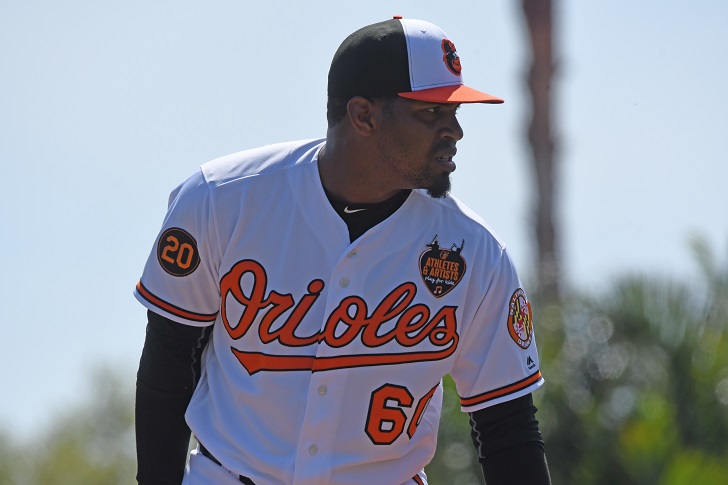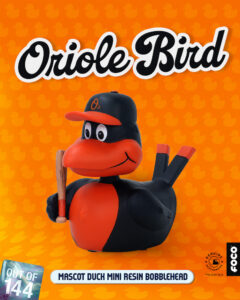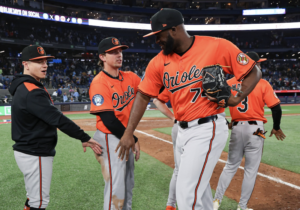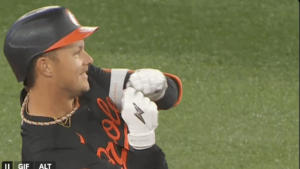A Quantitative Analysis of the Birds Before the Trade Deadline
We’re now past the halfway point of the 2019 MLB Season and trade rumors are already swirling. I don’t expect Mike Elias to be as active as Dan Duquette was at this time last year, but I do expect two or maybe even three Orioles to be dealt. I’ll take a look at eight potential trade candidates and show where they rank in advanced statistics. Front Offices value the advanced data much more in the modern day, along with contract controllability.
Mychal Givens

Mychal Givens is the strangest of cases among Oriole trade candidates. He’s having a career-high strikeout year (so is the rest of the MLB, it seems), but has had several disastrous outings that have ballooned his ERA. But looking at the graphic, Givens is ranking above the 50th percentile in eight advanced statistical categories. Most notably, Givens ranks in 94th percentile in K%, 82nd percentile in xBA (expected Batting Average), and 76th percentile in Fastball spin rate. This should suggest to a rival GM that Givens will improve.
Where Givens has suffered this season, is when he’s made mistakes with locating pitches. His command hasn’t been where it typically should be. This is evident but looking at a deeper dive into the numbers, Givens ranks in the bottom 6% in the league in Barrel % (barrels are measured in exit velocity combined with launch angle). Last year, Givens had just a 3.9% barrel rate, which ranked him in the top 8% in the league. If Givens can locate, he would almost assuredly have much better success.
One major pro for Givens is his contract status. He is under team control until 2021, meaning a team could be champing at the bit knowing he would help them for another two+ seasons. I’m higher on Givens than most Oriole fans for the simple fact that much of his peripheral stats are favorable and his control makes him attractive to teams, when he hasn’t even hit his age 30 season yet. The most comparable trade would be one that occurred just last year when the Indians agreed to part with Francisco Mejia for relievers Adam Cimber and Brad Hand. Now, I’m not saying Givens would command a prospect of the ilk of Mejia, probably not anything close, but it’s a trade we can look to where high-end relievers were valued for their controllability.
Trey Mancini

Trey is clearly having his breakout year as an Oriole. Although he’s slowed down of late, he still ranks around the 80th percentile in xBA, xwOBA (Expected Weighted On-Base Average), and xSLG (Expected Slugging Percentage). His ISO power ranks 57th in league, which isn’t great, but is a career high for him. Mancini’s defensive peripherals aren’t favorable, but he does have some versatility. I don’t think there’s much defensive value there, but rival evaluators may feel comfortable enough to stick him in the outfield.
Like Givens, Mancini’s greatest value is in his control. Compared to Givens, Mancini even has an extra year of control through 2022. All things considered, Mancini should warrant a Top 100 Prospect in return. Mancini is likely entering his prime now at age 27, and for three more years of control, I’d imagine his value will never be higher.
On the flip side, the Orioles could choose to extend Mancini, but you run the risk of not being competitive until Mancini is on the wrong side of 30.
Dylan Bundy

For someone who doesn’t throw very hard, Dylan Bundy has elite level spin rate on his fastball. Bundy ranks in the 88th percentile, better than pitchers like Walker Buehler and Lance Lynn who are both having exceptional statistical seasons. For as many home runs as Bundy allows, he doesn’t rank low in hard hit rate and hitters are barreling him up at a fairly average rate. So as you can see, he is as perplexing as Givens. His recent injury might sail his hope of being traded at the July 31st deadline, but a club may take a flier knowing he would be under control for another two years.
Bundy is someone I’d be curious seeing working in the pen exclusively. Through the first two times through the order, Bundy is allowing a .248 average. The third time through the order, Bundy is allowing a .306 average with a .906 OPS. This is pretty telling that he loses gas rather quickly and might be best served in a two inning role or so.
Andrew Cashner
(ed note: Matt submitted this blog on Saturday, before the Cashner trade was reported.)

Andrew Cashner has been a consistent, reliable starter for the Orioles…a ‘horse’ if you will. Teams are always looking for that kind of guy on the trade market. His advanced stats all reflect poorly. Cashner is also a drastic pitch-to-contact pitcher, relying on ground balls for success. The biggest difference this year is his WHIP. The 1.19 WHIP mark is his lowest since 2014 and he’s pace to walk the fewest number of batters since that 2014 season. Yes, he’s a free agent at the end of the season, but he’s relatively cheap. I could see a team like the Red Sox (ed. note – good call!) picking up Cashner as a player who won’t command a massive prospect package in return. In fact, the Red Sox minor league system is fairly barren, so they won’t have much to offer if they seek Matthew Boyd or someone else of a higher caliber.
I do expect Cashner to be traded even with his threat of retirement if he were to be traded. The Orioles should approach a trade with Cashner as the Phillies did when they dealt Jonathan Papelbon. Papelbon was on the downside of his career, but the Nationals had a big need to shore up their bullpen. The Nats parted with a relatively unknown prospect by the name of Nick Pivetta, who is now a part of the Phillies rotation. I’m sure Sig Mejdal and company can do some advanced work on a prospect yet to be seen as upper echelon, but who has the chance to develop based on their analytical performance.
Jonathan Villar

The thought in the back of the head of Dan Duquette when he acquired Jonathan Villar as part of the Jonathan Schoop trade had to be that he could flip Villar at some point. After all, Villar still has team control through next year. As you can see by his advanced stats, Villar’s only elite number is his sprint speed, in which he ranks in the 72nd percentile. The trade value comes from Villar’s speed. He does possess a little bit of pop, but is inconsistent offensively and can never seem to put together two good halves of a season.
He has defensive versatility in the infield and could be a pinch runner late in games if necessary. I think Villar has much more value than a Terrance Gore or even a Quintin Berry, but those types of players are invaluable come playoff time. Villar also makes his fair share of gaffes on the basepaths, which may give other GMs pause, but at the end of the day, I feel pretty certain that Villar gets traded at the deadline.
Pedro Severino

Pedro Severino arguably had All-Star caliber numbers in the 1st half, partly because AL catcher isn’t strong and partly because he appears to be coming into his own offensively. He’s increased his OPS from last year by over .300 points and showing power. Severino’s xBA ranks in the 85th percentile and he has strong numbers in both xwOBA and xSLG.
Whether or not he gets dealt will likely rely on two things: Strong trade offers (the obvious one) and whether the Orioles think Chance Sisco can take over at catcher full time. Severino provides value to the young Orioles pitchers who are still in development. Sevy works well with them, and that could be a valuable part of the rebuild until Adley Rutschman is ready to take over. It’s eye-opening to see Severino’s framing is ranked poorly and pop time is fairly average. Jesus Sucre could fill that veteran catcher role easily, but the Orioles may have something in Severino and may choose to let him develop a track record before dealing him to maximize the return.
Hanser Alberto

If there ever was Orioles Magic, it exists in Hanser Alberto. He perhaps has been the luckiest hitter in all of Major League Baseball. His exit velocity ranks in the 2nd percentile and hard hit % ranks in the 1st percentile! You won’t see anyone still hitting over .300 in baseball with those marks. Alberto has almost 300 plate appearances, so it’s certainly a long fluke. Our own Aidan Griesser wrote that Alberto should be the leadoff hitter of the future, and every day Alberto somehow proves me wrong. He truly is a statistical anomaly, which is why I really believe his trade value will never be higher. Even if the O’s can flip him for a fringe prospect, I’d consider that a win. Or, maybe they choose to hold onto Alberto. There’s no reason to deal him for peanuts if he could somewhat stabilize the infield. I really don’t think there will be all that much interest, but Alberto was third in the AL Batting Crown just a week and half ago, so who knows.
I don’t think this trade deadline will be as compelling as last year’s, but it will be interesting to see how Mike Elias handles his first one as the guy in charge. The Orioles Farm System is certainly on the come-up and if Elias’ goal of increasing the level of talent throughout the organization is to come to fruition, this could be a great way to keep the momentum going.
[All statistics and graphics via BaseballSavant.com]









